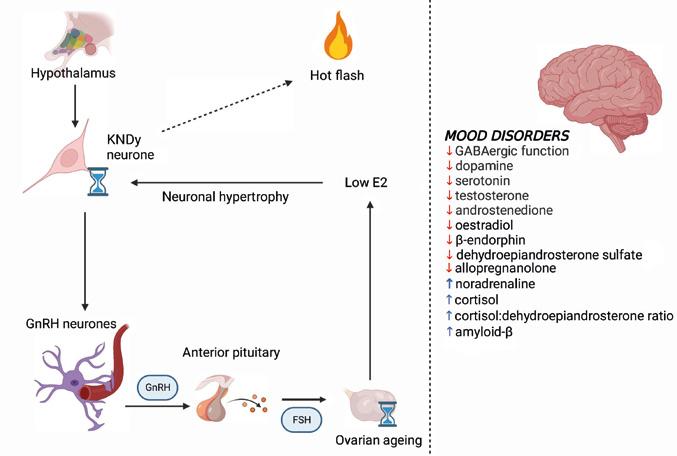
5 minute read
Mental impact of the menopause
The perimenopausal transition represents a window of vulnerability for developing depressive symptoms,1 presenting in combination with hot flashes and night sweats.2
Risk factors for perimenopausal mood disorders include premenstrual symptoms, nulliparity, separation from a prior spouse, and smoking.3 Perimenopausal women tend to experience irritability, poor concentration, impaired memory, difficulties in multitasking, loss of interest and enjoyment, and mood swings.2,4
Mood disorders
Mood disorders in ageing individuals are closely related to neuroendocrine alterations in the central nervous system (CNS) (Figure).1,3
Women who experienced a rapid increase in levels of follicle-stimulating hormone (FSH) levels before the final menstrual period have a lower risk of perimenopausal depression in comparison with women with a slower increase in FSH levels. Moreover, the availability of noradrenaline and serotonin at the synaptic level is reduced, secondary to oestrogen deficiency, further predisposing to mood disorders.
In addition, menopause-related depressive symptoms have been associated with fluctuations in allopregnanolone. This progesterone-derived neurosteroid regulates the GABA receptor. The inability to maintain the control of GABAergic homeostasis, secondary to the alternating hormonal environment, leads to a dysregulated response of the hypothalamus− pituitary−adrenal axis to stress. These changes increase the vulnerability to depression during midlife, particularly in women with a history of postpartum depression or premenstrual dysphoric disorder.1,3
Hot flashes and night sweats
Climacteric symptoms, namely hot flashes and night sweats, overlap with depressive symptomatology (Figure). At the same time, they are also known to modify the risk of future depressive symptoms in women with prior history of depression.
The neuroendocrine pathophysiology of hot flashes has received significant attention lately. The hypothalamic neurones of the infundibular nucleus (KNDy neurones) produce neuropeptides such as kisspeptin, neurokinin B (NKB) and dynorphin, and also express oestrogen receptors. The KNDy neurones regulate the function of the gonadotrophinreleasing hormone (GnRH) pulse generator and project to the preoptic thermoregulatory area. Ageing and oestrogen fluctuation lead to hypertrophy of the neurones in the infundibular nucleus and, later on, to reduced expression of the dynorphin gene and increased expression of the genes for kisspeptin and NKB. These genomic changes lead to increased signalling to GnRH neurones and to heat dissipation effectors in the CNS. The KNDy neurones are also thought to regulate body temperature, playing a role in the emergence of vasomotor symptoms.1
Treatment options
The choice of treatment is related mainly to the severity of the symptoms. Counselling and psychoeducation are required, while the treatment plan should be based on shared decision making.2
In cases with mild symptoms, primary care physicians are encouraged to adopt watchful waiting, with a low intervention threshold, reassessing the patient at 2 weekly intervals.
In cases with persistent or worsening symptoms, further treatment is indicated, which usually consists of psychotherapy or pharmacotherapy, perhaps including menopause hormone replacement therapy (MHT). An imminent referral for psychotherapy or pharmacotherapy is encouraged in cases with moderate or severe symptoms. However, MHT initiation is not beneficial in cases with severe depression. The next step consists of weekly monitoring and clinical re-evaluation after 3−4 weeks. The treatment can be continued if the symptoms improve by more than 50%. If the symptoms do not improve significantly, the treatment should be adjusted, and regular monitoring is required (every 1−2 weeks).2
Pharmacotherapy
Therapeutic alternatives vary from regular antidepressants to psychoeducation and MHT. Pharmacotherapy includes options as follows:2
a) Selective serotonin reuptake inhibitors (citalopram: starting dose 20mg/day, usual dose 20−40mg/day; escitalopram: starting dose 10mg, usual dose 10−20mg/day; fluoxetine: starting dose 20mg/day, usual dose 20−60mg/day).
b) Serotonin−norepinephrine reuptake inhibitors (desvenlafaxine: starting dose 25−50mg/ day, usual dose 50−100mg/day; venlafaxine: starting dose 37.5−75mg/day, usual dose 75−375mg/day; duloxetine: starting dose 30−60mg/day, usual dose 60−120mg/day).
c) Other options include selective norepinephrine− dopamine reuptake inhibitors (e.g. bupropion), α1-receptor antagonists (e.g. mirtazapine), serotonin modulators, tricyclics, and tetracyclics (e.g. amitriptyline).
Menopause hormone replacement therapy
The use of MHT in peri- and postmenopausal women with depressive symptomatology remains inconclusive.2 MHT is not approved for the pure treatment of perimenopausal depression. However, MHT is an effective option for controlling the severity of vasomotor symptomatology and other menopause-related complaints. Hence a positive effect on negative mood is anticipated.2 On the other hand, recent data5 described that regular intake of antidepressants could impact serum levels of sex hormones by dysregulating the function of the hypothalamus−pituitary−adrenal axis and, consequently, the female response to triggers of anxiety and stress. The precise direction of this interaction and the related clinical implications are still to be investigated by future studies.5

Neuroendocrinological pathways contribute to the development of psychological disorders around and after the time of the menopausal transition. On the left-hand side, the flowchart presents the pathways in the origin of peri- and postmenopausal hot flashes. On the right-hand side, the panel summarises the alterations in levels of neurosteroids triggered by oestrogen deficiency. E2, oestradiol. The figure was created using Biorender.com.
In summary
The use of antidepressants with or without psychoeducation and MHT has proven beneficial in controlling mood disorders. However, the administration of MHT monotherapy to regulate mood disorders is not indicated.
Eleni Armeni, UK
REFERENCES
1. Monteleone et al. 2018 Nature Reviews Endocrinology 14 199−215 https://doi.org/10.1038/nrendo.2017.180
2. Stute et al. 2020 Maturitas 131 91−101 https://doi.org/10.1016/j.maturitas.2019.11.002
3. Santoro et al. 2021 Journal of Clinical Endocrinology & Metabolism 106 1−15 https://doi.org/10.1210/clinem/dgaa764
4. Lambrinoudaki et al. 2022 Maturitas 163 1−14 https://doi.org/10.1016/j.maturitas.2022.04.008
5. Pavlidi et al. 2021 European Journal of Pharmacology 899 173998 https://doi.org/10.1016/j.ejphar.2021.173998










